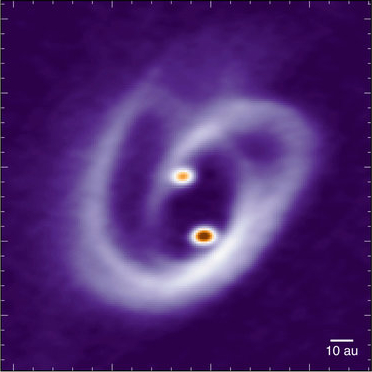Astronomers photograph baby binary system
Using the Atacama Large Millimetre/submillimetre Array (ALMA), astronomers have obtained the first high resolution image of a baby binary system, its two young stars dancing within a joint accretion disk.
Most stars in the universe come in the form of pairs – binaries – or even multiple star systems. Now, the formation of such a binary star system has been observed for the first time with high-resolution ALMA (Atacama Large Millimetre/submillimetre Array) images. An international team of astronomers led by the Max Planck Institute for Extraterrestrial Physics targeted the system [BHB2007] 11, the youngest member of a small cluster of young stellar objects in the Barnard 59 core in the Pipe nebula molecular cloud. While previous observations showed an accretion envelope surrounding a circum-binary disk, the new observations now also reveal its inner structure.
“We see two compact sources, that we interpret as circum-stellar disks around the two young stars,” explains Felipe Alves from MPE, who led the study. “The size of each of these disks is similar to the asteroid belt in our Solar System and their separation is 28 times the distance between the Sun and the Earth.” Both proto-stars are surrounded by a circum-binary disk with a total mass of about 80 Jupiter masses, which contains a complex network of dust structures distributed in spiral shapes. The shape of the filaments suggests streamers of in-falling material, which is confirmed by the observation of molecular emission lines.
Why most stars form as binary systems is as yet not understood. This data is a major first step towards figuring this out.
Using the Atacama Large Millimetre/submillimetre Array (ALMA), astronomers have obtained the first high resolution image of a baby binary system, its two young stars dancing within a joint accretion disk.
Most stars in the universe come in the form of pairs – binaries – or even multiple star systems. Now, the formation of such a binary star system has been observed for the first time with high-resolution ALMA (Atacama Large Millimetre/submillimetre Array) images. An international team of astronomers led by the Max Planck Institute for Extraterrestrial Physics targeted the system [BHB2007] 11, the youngest member of a small cluster of young stellar objects in the Barnard 59 core in the Pipe nebula molecular cloud. While previous observations showed an accretion envelope surrounding a circum-binary disk, the new observations now also reveal its inner structure.
“We see two compact sources, that we interpret as circum-stellar disks around the two young stars,” explains Felipe Alves from MPE, who led the study. “The size of each of these disks is similar to the asteroid belt in our Solar System and their separation is 28 times the distance between the Sun and the Earth.” Both proto-stars are surrounded by a circum-binary disk with a total mass of about 80 Jupiter masses, which contains a complex network of dust structures distributed in spiral shapes. The shape of the filaments suggests streamers of in-falling material, which is confirmed by the observation of molecular emission lines.
Why most stars form as binary systems is as yet not understood. This data is a major first step towards figuring this out.

